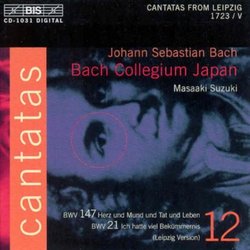| All Artists: Johann Sebastian Bach, Masaaki Suzuki, Robin Blaze, Gerd Turk, Yukari Nonashita, Peter Kooy, Bach Collegium Japan, Concerto Palatino Title: Bach: Cantatas Vol 12 (BWV 147, 21) /Bach Collegium Japan * Concerto Palatino * Suzuki Members Wishing: 0 Total Copies: 0 Label: Bis Original Release Date: 3/27/2000 Re-Release Date: 3/15/2000 Album Type: Import Genre: Classical Styles: Opera & Classical Vocal, Historical Periods, Baroque (c.1600-1750) Number of Discs: 1 SwapaCD Credits: 1 UPCs: 675754162122, 7318590010310 |
Search - Johann Sebastian Bach, Masaaki Suzuki, Robin Blaze :: Bach: Cantatas Vol 12 (BWV 147, 21) /Bach Collegium Japan * Concerto Palatino * Suzuki
 | Johann Sebastian Bach, Masaaki Suzuki, Robin Blaze Bach: Cantatas Vol 12 (BWV 147, 21) /Bach Collegium Japan * Concerto Palatino * Suzuki Genre: Classical
Many people will be interested in this title just for Herz und Mund und Tat und Leben, cantata No. 147, the source of the much-loved chorale arrangement "Jesu, Joy of Man's Desiring." The Bach Collegium Japan performs th... more » |
Larger Image |
CD Details
Synopsis
Amazon.com
Many people will be interested in this title just for Herz und Mund und Tat und Leben, cantata No. 147, the source of the much-loved chorale arrangement "Jesu, Joy of Man's Desiring." The Bach Collegium Japan performs the chorale very nicely indeed, as well as the cantata's four arias and jubilant opening chorus. The other work on this disc is the great cantata No. 21, Ich hatte viel Bekümmernis, which progresses from anguished repentance to serene happiness and triumphant joy. The BCJ recorded Bach's first version of this cantata (from 1714) on volume 6 of this series; volume 12 presents the revision Bach made in 1723. Some differences aren't great (reassignment of a couple of arias and a lower pitch), while others are striking, such as the explicit division of portions of some choruses between soloists and choir, and the addition of trombones (considered quite old-fashioned by 1723) to one chorus. Was it worth recording the work a second time? With Masaaki Suzuki's superb chorus, orchestra, and four soloists in top form--absolutely. --Matthew Westphal

 Track Listings (21) - Disc #1
Track Listings (21) - Disc #1